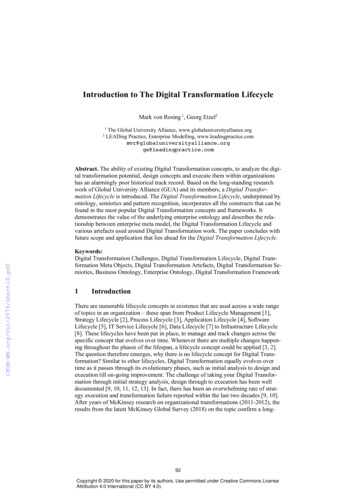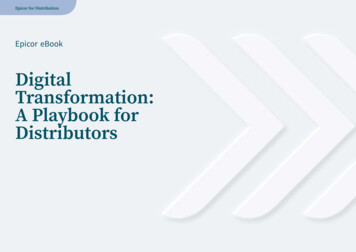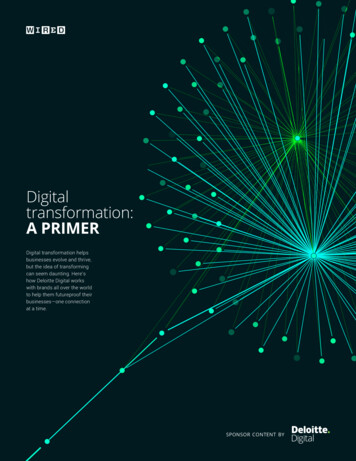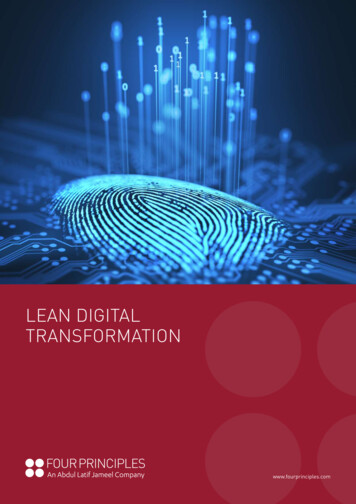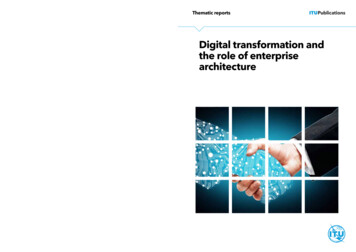
Transcription
Thematic reportsITUPublicationsDigital transformation andthe role of enterprisearchitectureInternational Telecommunication UnionTelecommunication Development BureauPlace des NationsCH-1211 Geneva 20SwitzerlandISBN: 978-92-61-29011-59 789261 290115Published in SwitzerlandGeneva, 2019
Digital transformation and therole of enterprise architecture
AcknowledgementThis report was prepared for the International Telecommunication Union (ITU) by Pallab Saha,Chief Architect at the Open Group in coordination with the support of the ITU TelecommunicationDevelopment Bureau (BDT) ICT Applications and Cybersecurity Division of the Infrastructure, EnablingEnvironment, and E-Applications Department.ISBN978-92-61-29001-6 (paper version)978-92-61-29011-5 (electronic version)978-92-61-29021-4 (EPUB version)978-92-61-29031-3 (MOBI version)Please consider the environment before printing this report. ITU 2019All rights reserved. No part of this publication may be reproduced, by any means whatsoever, without the priorwritten permission of ITU.
Executive SummaryDigital Transformation is becoming increasingly a focus of strategic thinking and planning of many publicand private organizations. It is about putting the emphasis on how digital services and applicationswill change and “transform” citizen’s experience and the way we do business in a way that will lead toimprovement in quality of life and wellbeing and the attainment of Sustainable Development Goals (SDG).This paper provides an introduction on how digital services and applications are to be shaped anddelivered to induce this transformation for government public services and other sectoral areas andthe central role of enterprise architecture to reach this.Digital services need to be personalised, paperless, cashless, presenceless, integrated and consentbased to be transformational. Countries and organizations need to develop specific capabilities to beable to deliver such transformational digital services. The paper identified eight first level buildingblocks – digital strategy, digital platform, value delivery ecosystem, digital service attributes, digitalenterprise architecture, institutions and governance, citizen insights and delivery capabilities that arerequired as foundation to ideate, plan, design, deploy and operate citizen-centric transformationaldigital services.All those building blocks are interrelated and depend on each other. Every building block plays a criticalrole in the journey towards digital transformation.A central building block is the digital enterprise architecture, which is the whole-of-governmentapproach to support government ecosystems by transcending boundaries to deliver services in acoordinated, efficient and equitable manner. It is the critical component that translates transformationneeds into specific functional and technical requirements that can lead to the deployment oftransformation digital services.A digital platform is the result of enterprise architecture. A digital platform is a repository of business,data, application and technology components (reusable building blocks and distinct interfaces) thatallow for rapid design, development, deployment and delivery of digital services. With the use ofstandard and open interfaces, the digital platform is available to all the key actors in the value deliveryecosystem to build and use components. It will accelerate innovation in integrated and interoperabledigital solutions, enabling government to achieve its goals in a more predictable, efficient and costeffective manner—and with reduced risk.Missing investment to develop such architecture and consequently the digital platform will lead tofragmented, siloed and duplicative digital services, which is one of the main impediments againstleveraging digital services that can induce desired transformation.The paper presents also some country examples that managed to set the required foundations forchange and an enabling ecosystem with the enterprise architecture at its core and a set of principlesas the basis for digital transformation of governments.There is still significant lack of expertise and awareness in many countries that prevent them frominvesting to build such critical capabilities. This paper aims to address some of those gaps by emphasizingwhere countries need to invest and why to advance in their digital transformation journey.iii
Table of ContentsExecutive Summary iiiIDigital transformation 1IIFour levels of digital transformation maturity 1III Pathways to success 3IV Digital transformation value chain 3V5Digital transformation building bocks VI Digital Transformation@ Work 9VII Digital transformation maturity assessment 13VIII Digital transformation in selected countries 13IX Concluding thoughts 18v
List of FiguresFiguresFigure 1: The four levels of digital transformation maturity Figure 2: Pathways to digital transformation maturity Figure 3: Digital Transformation Value Chain Figure 4: Digital transformation continuum Figure 5: Digital transformation building blocks Figure 6: Role and Involvement of Citizens in the Digital Service Lifecycle Figure 7: Impact of missing building blocks Figure 8: Digital transformation readiness assessment Figure 9: Digital transformation dynamics in governments Figure 10: Longitudinal journey of eGovernance in India leading to Digital India vi234567891214
Digital transformation and the role of enterprise architectureIDigital transformationDigital transformation is now an essential part of strategic thinking for the public and private sectors.Factors driving digital transformation range from technology ubiquity, to demand for newer businessmodels and delivery excellence. The imperative for transformation has never been greater and thereality for many is to move with, if not lead, the change or be left behind.From a digital services perspective, digital transformation is a continuous process of multi-modaladoption of digital technologies that fundamentally change the way government and private sectorservices are ideated, planned, designed, deployed and operated such that they are personalized,paperless, cashless, presenceless, frictionless, and consent-based.The construct of digital services is critical because governments and other public or privateorganizations interact with citizens, businesses and other entities through those services.Digital transformation in government has the potential to modernize both government and publicservices, and vastly improve citizen experience. Digital technologies are penetrating governmenteconomic, social and political mandates in unprecedented ways, accelerating transformation.If digital transformation is more about strategic thinking and change, and less about technology, thensuccessful transformation efforts depend on two critical dimensions: ubiquity and change. These twovery distinct dimensions reflect digital transformation maturity, each playing a role: ubiquity is the degree to which digital services support the multiple requirements of stakeholdersand harness enterprise architecture for government and private sectors; change is the degree and the pace at which government and private sector stakeholders deliverdigital services to meet citizen or customer expectations, especially in the interdependentecosystems of regulation, policy, strategy, structure, systems, skills, shared goals, staff and styleof governance.IIFour levels of digital transformation maturityThe combination of ubiquity and change yields four distinct levels of digital transformation maturity: digital trailblazer; digital leader; digital follower; digital laggard1.Public and private sector ‘digital laggards’ are weak in both ubiquity and change, often leading to afragmented and disjointed approach to services, a lack of whole-of-government or whole-of-enterprisestrategic thinking, characterized by information siloes with limited exchange, a significant amountof duplication and redundancies, and a lack of focused, well-directed effort. For this group, changeinitiatives are few and often unsustainable. There is tentativeness in what they do and often, good1Refers to slow adopters, such as the elderly, who use friends and neighbours as information sources, dislike change,and accept new things only when forced to.In diffusion of innovation theory every market has groups of customers who differ in their readiness and willingnessto adopt a new product, that an innovative product spreads (diffuses) through a market not in one straight coursebut in successive, overlapping waves. Most populations show the following pattern in the adoption of new consumergoods: innovators (2 percent of population), early adopters (14 percent), early majority (34 percent), late majority (34percent), and laggards (16 percent). http:// www .businessdictionary .com/ definition/ diffusion -of -innovation .html1
Digital transformation and the role of enterprise architectureresults (if any) are attributable to chance rather than design. Unable to establish the real purpose oftransformation, members of this level of digital transformation maturity do not create enablers nororchestrate success factors to their advantage.Figure 1: The four levels of digital transformation maturityDigital followers are more traditional and classical in their approach. These entities prefer to changein incremental steps with minimal disruption to ways of doing things. Followers are inclusive bydesign, taking all parts of the organization along the transformation initiative. The premise is to maketransformation more widespread and ensure that everyone is part of the journey – no one is leftbehind. Followers are usually not the first to embrace transformation, and when they do, they maylack the political and operational capability to pull off a big change. This is attributed to not havingenablers and success factors in place at the start, and taking incremental steps is to build these.Followers are slow movers for multiple reasons, and if they face impediments, followers may reversethe gains from digital transformation.Digital trailblazers exhibit characteristics that are in stark contrast to digital followers. With anunderstanding of the enormity of digital transformation, trailblazers accept that it is not practicallypossible to move every part of the organization at the same pace. Trailblazers acknowledge that thereare always parts of the organization that are more forward thinking, and willing and able to movemore quickly than others, creating islands of excellence. Trailblazers adopt digital technologies quicklyand the islands of excellence build internal credibility before being scaled up.Digital leaders do well across both dimensions and combine traits of both digital followers and digitaltrailblazers. Digital leaders are visionary in their approach and understand how to manage change andrecognize it as a critical success factor to digital transformation. The ability to apply transformationacross multiple cycles is a digital leader hallmark, and success supports a strong reinforcing cycle bringingin further change. Leaders accept and factor in complexity, setbacks, and failures when embracingwidespread and breakthrough transformation. Leaders like to experiment, learn and move ahead. Inmost scenarios, leaders do not wait for examples, instead they create examples for others to emulate.2
Digital transformation and the role of enterprise architectureIIIPathways to successMost countries and organizations begin their digital transformation journey in the lower left quadrant,i.e. as digital laggards due to the speed at which digital technologies are available, but transformationis slow due to slow take-up and a lack of success.Figure 2: Pathways to digital transformation maturityOnce a country decides to engage in the digital transformation, there are three basic options, it cansupport the pathway to becoming a trailblazer, it can build gradual consensus and internal capabilitybefore pressing ahead, and it can directly move into the leader level, bypassing the transition levels,which softens the disruption of digital transformation. Without sustained effort it is also possibleto move back and forth between levels. This happens when the obstacles and challenges becomeunsurmountable and negate all progress.IVDigital transformation value chainAlmost every country has or at least claims to have a digital transformation initiative. The sixfundamental attributes of services that make them digital are: Personalised services are designed and delivered to suit the specific requirements of those whoconsume them. Personalisation is generally achieved by way of giving citizens a great experiencethat augurs to their needs and expectations. Paperless services are automated by adopting widespread automation. Paperless services are aconsequence of extensive business process reengineering and significant fundamental rethinking. Cashless services are a key aspect of digital economy. Cashless transactions for services thathave monetary dimensions in cashless economy requires an integrated ecosystem of regulators,financial institutions, banks, payment mechanisms to work in tandem. Presenceless services are designed with the underlying premise that human interventions wouldbe kept to the minimum. A presenceless service is enabled by insights into citizen behaviours,creation of interaction patterns and encoding them into service design and delivery.3
Digital transformation and the role of enterprise architecture Frictionless services are designed and delivered end-to-end. This means that citizens are notexposed to all the internal coordination and exchange of information that takes place betweendifferent ministries and departments, but what they receive is an integrated experience.Frictionless (or seamless) services are enabled by a boundaryless flow of information. Consent-based services refer to security and data privacy, two imperatives that have to be focusedon with utmost priority. In the digital era, people share huge amounts of information, citizenconsent has a hugely significant impact on the effectiveness of digital services. People must knowwhat data is being collected, who is collecting it, and for what purposes is it going to be used.If leadership inertia to change is proving to be the biggest challenge, it is important to project digitaltransformation as a value creating activity. The digital transformation value chain structures theinitiative as a series of value functions working in synergy.Figure 3: Digital Transformation Value ChainThe bottom-half of the value chain illustrates the various successive stages (prepare to monitor) oftransformation initiatives. The output from each stage forms the input to the next stage in the flow.In the top-half of the value chain are horizontal functions that enable the stages and value functionsof the bottom-half. The enabling value functions in the top-half are generally ongoing activities thatare continuous in nature, amplifying the effectiveness of value functions in the bottom-half.The digital transformation value chain provides a high-level process to be followed. In traversing thevalue chain, key issues that need to be asked and re-asked include:4 Vision and ambition: To what do we aspire? Do we have the determination to get there? Purpose: Why are we doing this? How will it improve what we are already doing? What keepsus motivated? Enabler: What will give us the means to achieve? What will support our capacity to deliver? Success factor: What must we get right for us to succeed? What could impede success? Technology: What digital technologies should be use? What is our level of expertise to adoptspecific technologies? Digital Service (Portfolio): Which services should be digitised? Are these new or existingservices? How will we make a smooth transition with minimal disruption?
Digital transformation and the role of enterprise architecture Drivers: What are the critical elements that are aiding this initiative to progress and succeed?Are these drivers working in tandem?These seven issues are the components of digital strategy, which are put together to form the digitaltransformation continuum. These are in a continuum as they are distinct yet interrelated, sequencedand persistent.Figure 4: Digital transformation continuumVDigital transformation building bocksDigital transformation places a premium on speed and agility, but demands such massive organisationalchanges that it takes a long time with sustained efforts to become a digital leader. It is thereforeimportant to identify and understand the various components of digital transformation that mustwork synergistically. These are called the building blocks, which are capabilities that countries willneed to succeed. These building blocks establish a foundation to ideate, plan, design, deploy andoperate citizen-centric digital services.There are eight first level blocks – digital strategy, digital platform, value delivery ecosystem, digitalservice attributes, digital enterprise architecture, institutions and governance, citizen insights anddelivery capabilities.The value delivery ecosystem consists of key stakeholders who are actors in the digital service lifecycle(ideate, plan, design, deploy and operate). In this ecosystem, the emerging role of aggregators cannotbe overemphasised. Aggregators are organisations that collect information on goods and services fromseveral competing sources (providers) and make that information available in a more consumable formto potential users (consumers) via a digital platform. The aggregator value lies in the ability to createan environment that attracts consumers to the platform and enable delivery of the goods and services.5
Digital transformation and the role of enterprise architectureFigure 5: Digital transformation building blocksThe digital enterprise architecture is the whole-of-government approach to support governmentecosystems by transcending boundaries to deliver services in a coordinated, efficient and equitablemanner. The aim is to establish best-in-class architectural governance, processes and practices withoptimal utilisation of ICT infrastructure and applications to offer one government experience to thecitizens and businesses through digital services enabled by Boundaryless Information Flow 2. Theenterprise architecture consists of eight second level building blocks covering the eight architecturedomains. These are: Performance: The mission, goals and measures to guide priorities, decisions and outcomes. Fordigital transformation, it is recommended that the UN Sustainable Development Goals form thefoundation for performance domain. Business: The services, capabilities and processes to operationalise and realise performance. Data: The way data and information are described, stored, exchanged and treated to gainactionable insights. Application: The software and IT systems that enable business and operations with automation. Technology: The physical ICT infrastructure that enables / restricts the ability to act. Security: The way information is protected and made available for all legitimate reasons. Integration: The way in which all aspects converge and harmonise to work together towardscommon goals. Governance: The decision rights and accountabilities required for architecture to function smoothly.Several countries have expended significant efforts towards development of national enterprisearchitectures3. In the United States of America, the Republic of Korea, and Estonia, governmententerprise architecture is mandated by law, and India is working towards the same end.A digital platform is a repository of business, data, application and technology components (reusablebuilding blocks and distinct interfaces) that allow for rapid design, development, deployment and236The Open Group. (2019).Enterprise Architecture for Connected E-Government – Practices and Innovations; Pallab Saha; IGI Global, PA UnitedStates. (2012).
Digital transformation and the role of enterprise architecturedelivery of digital services. With the use of standard and open interfaces, the digital platform isavailable to all the key actors (in the value delivery ecosystem) to build and use components. A digitalplatform is the result of enterprise architecture.Digital transformation stands on the three foundational pillars of institutions and governance, citizeninsights, and delivery capabilities. These are absolute imperatives.Figure 6: Role and Involvement of Citizens in the Digital Service LifecycleKnowing and understanding the citizens for whom the digital services are being developed and deployedis paramount to effective transformation. Citizen insight is at the heart of digital transformation.Digital technologies are changing the way citizen interactions are happening, with new rules andopportunities that were unthinkable a few years ago. Government services delivered via multiplechannels need to be coherent and provide a consistent experience. Adoption of such digital servicesrequires a change in citizen behaviour and habits. Digital interactions force the evolution in culture,decision-making methods and rules, which may run counter to traditional ways of doing things. It isthis transition that takes time to internalise.Establishing the right institutions and governance mechanisms provide the necessary teeth to pushthrough the transformation agenda – a case in example being the Australia Digital TransformationAgency4. First and foremost is the identification of leaders and champions who drive the transformationinitiative, which is also apparent in the digital transformation value chain. Without leaders andchampions digital transformation remains a non-starter. The second part of this pillar is to ensurethat the vision and benefits of digital transformation are sufficiently understood by all the ecosystemactors. This creates momentum and encourages the correct behavioural changes that are so centralto success. A coalition of the business and IT groups with clear accountability and decision rights iscritical. The role of standards and guidelines in scaling up and scaling out cannot be overemphasised.Standards focus innovation and allow countries to target the things and issues that matter, such asimproving service quality and citizen experience.Excellence in delivery capabilities ensures that there is enough internal capability to take on andsuccessfully accomplish the goals of digital transformation. This level of transformation demandsan entrepreneurial and innovation oriented mind set. The ability to experiment and learn is very4Digital Transformation Agency, Government of Australia (https:// www .dta .gov .au/ ). (2018).7
Digital transformation and the role of enterprise architectureimportant and requires an agile approach which integrates architecture, development and operations(Arch-Dev-Ops), an extension from DevOps.Digital transformation results in multiple projects, which have to be handled as a portfolio withadequate risk management capabilities that come with operational mastery. Usually there is a lot ofattention to ‘new things’ when discussing digital transformation. However, even with the adoption ofdigital technologies, certain portions or segments will continue to operate in their traditional ways andsuch diversity has to be absorbed. This is catered by building the capability to deal with multi-speeddelivery and yet maintaining overall coherence.Every building block plays a critical role in the journey towards digital leadership. One or moremissing building blocks have a very significant impact and can be the reason for derailment of thedigital transformation initiative. Underlining the importance of each building block is as important asmaintaining a balance between them while navigating the transformation journey, and digital leadersare expected to manage all building blocks concurrently in situations often characterised by volatility,uncertainty, complexity and ambiguity.Figure 7: Impact of missing building blocksA consideration of the building blocks leads a country or an organisation to identify factors that areuseful to evaluate whether they are ready to embark on the digital transformation journey. Thesefactors are shown in the table in Figure 8, and is consistent with first value function in the digitaltransformation value chain. Each factor will require multiple questions to make an assessment. Thesequestions will need to be put together to develop and administer a readiness assessment survey.8
Digital transformation and the role of enterprise architectureFigure 8: Digital transformation readiness assessmentVIDigital Transformation@ WorkDone well, digital transformation can bring immense benefits. But it will demand a massive culturalchange (a paradigm shift in culture) to make it successful. Digital transformation needs a strategyand a connected and holistic view, not a piecemeal approach. A system is a set of things—people,cells, molecules, or whatever—interconnected in such a way that they produce their own pattern ofbehaviour over time. The system may be buffeted, constricted, triggered, or driven by outside forces5.This is the central core of systems thinking, which is used to understand and analyse the dynamics ofdigital transformation in governments using causal loop diagrams. Information holds systems togetherand plays a great role in how they operate and behave. However, information-based relationshipsare hard to see.Many governments are experiencing the transformative power in revitalizing public administration,overhauling public management, fostering inclusive leadership and moving civil service toward higherefficiency, transparency and accountability. This creates the need to:1.change the way services are delivered and consumed;2.change the way internal back office operations are executed; and3.change the way resources and processes are sourced and combined.It is in this context governments are looking at digital technologies to bridge policies and outcomes,leading to more government services being offered electronically. Factors like service deliveryinnovation, distributed governance and data driven policies and decisions contribute to the complexityof government operations, which raises citizen expectations and demand for digital technologiesas a means to address such expectations. There is enough evidence that adoption of technologyminimises corruption, which in turn raises trust in government. This trust aids the country to looktowards building future-ready government, thereby creating a strong reinforcing cycle (see Figure 9:R1: Government Competiveness as Genesis).ICT is increasingly a central part of national competitiveness strategy and is a key enabler of socioeconomic progress and development, productivity enhancement, modernisation, economic growthand even poverty reduction. Digital government focus and capability provides the raw material toimprove the overall ICT capability by way of greater resources, access to talented and trained people,attracting investments, expertise in research and development, supporting policies and governance5Thinking in Systems; Donella H. Meadows; Sustainability Institute, London. (2009).9
Digital transformation and the role of enterprise architectureamong other enabling inputs. Greater ICT capabilities provide the necessary impetus to the emergenceof the ICT industry. There are several countries that have utilised their foray into digital governmentas an entry point to build their national ICT sector leading to a digital economy (see Figure 9: R2: ICTInvestment Growth and R3: Multiplier Effects of Digital, which feeds into R1 to strengthen the needto build the future tech-enabled government).Government enterprise architecture provides a business-centric view of government operations andusually organises government operations through components like business areas, lines-of-businessand business functions. Such standard approaches tend to discourage and overlook the need foroperational diversity that is needed at the department level. Governments (and their departments)are under pressure to retain and even enhance operational autonomy. The trend of ministries anddepartments operating with a high degree of autonomy leading to diverging agendas is common andinstrumental in putting breaks on government-wide transformation activities, and suspicion aboutthe role of digital technologies can become an impediment (see Figure 9: B1: Diverging Agendas).The emergence of the ICT industry, in general, drives adoption of ICTs. As societies embracedigital technology, the inclusion and participation of citizens into the digital landscape improvese-participation. This creates demand for online services, as a tech-savvy society appreciates thebenefits of online services. This further contributes to enhancing the online service index (seeFigure 9: R4: EGovernment Readiness). In itself, this reduces the digital divide aided by the factthat technology is largely affordable. Technology acts as an accelerator to digital government. As thismaturity improves, the ability of governments in designing and delivering online services improves,which further make it attractive for ICT investments (see Figure 9: R3: Multiplier Effects of Digital).The impact of operational diversity amongst ministries and departments leads to the emergenceof businesses that operate in their own silos. Amplified by diverging agendas, business silos areinstrumental in creating and abetting feudal forms of governance. Government information officersoperate with negligible interactions both with the business (domain) side and IT organisations of otherministries or agencies (see Figure 9: B2: Tech Empires). The silo mindset is even more ingrained on thebusiness side of operations. Government departments like and demand to operate in their respectiveareas
blocks - digital strategy, digital platform, value delivery ecosystem, digital service attributes, digital enterprise architecture, institutions and governance, citizen insights and delivery capabilities that are required as foundation to ideate, plan, design, deploy and operate citizen-centric transformational digital services.







